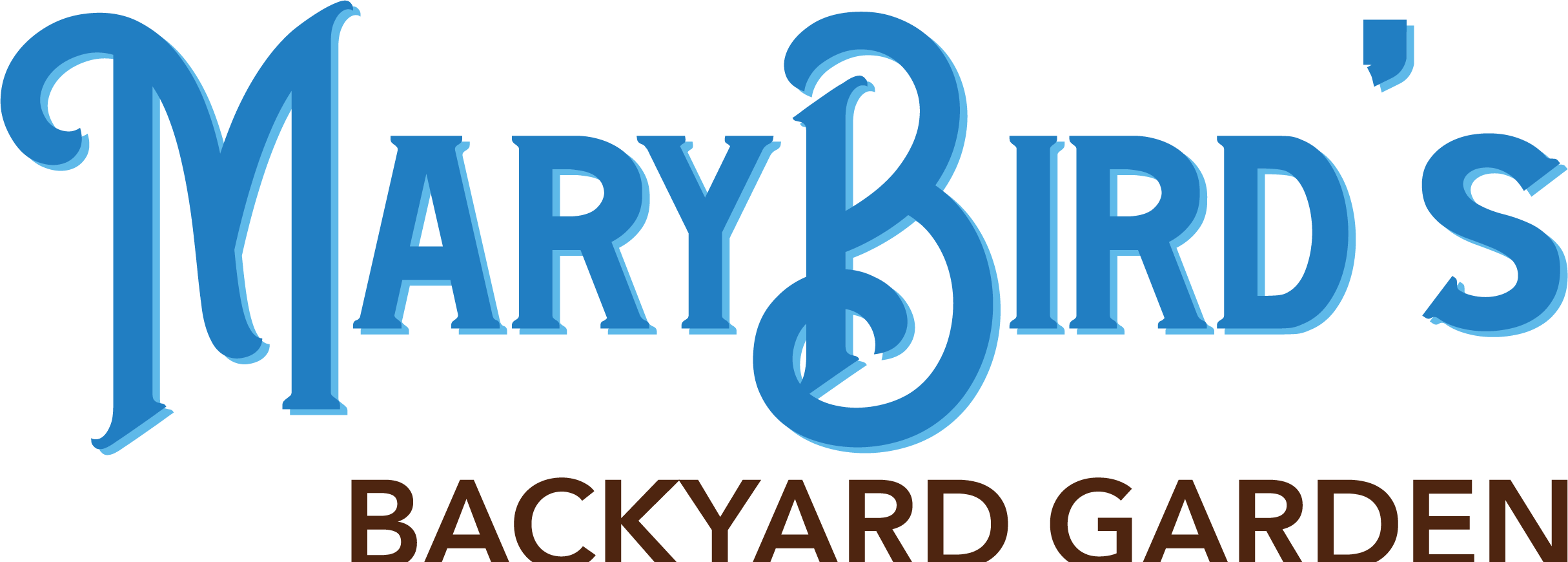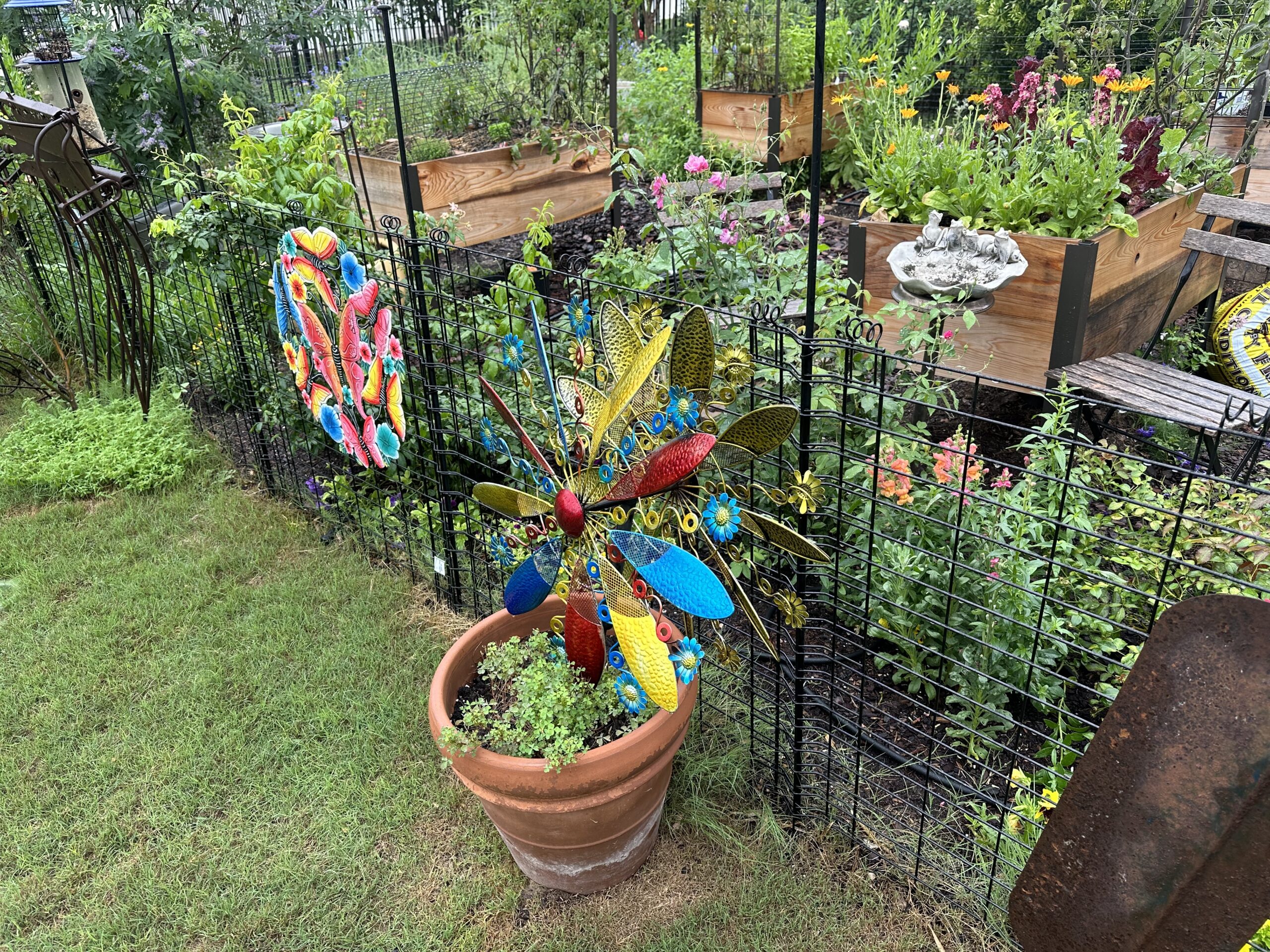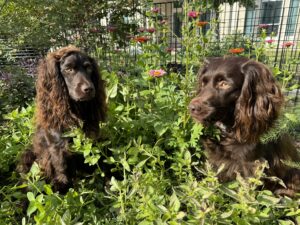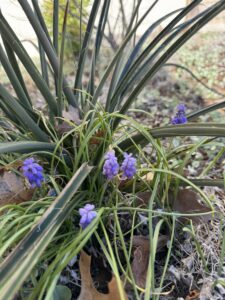Though the exact way in which Jeff first brought up a Pocket Prairie is lost to history at this point, I remember watching a You Tube episode named: Native Plant Rescue + Urban Pocket Prairie from season 28 of the Central Texas Gardener channel. I was inspired by John Hart Asher’s presentation of landscaping a historic, downtown Austin property in a prairie grassland theme. Well many of the concepts discussed in this video correlate with goals Jeff and I have for our own garden.
We have a section of our garden along our south fence border that has developed a mishmash feel now that we have been putting plants in willy nilly. I’m thinking that this section may become an upcoming fall Pocket Prairie project.
What is a Pocket Prairie?
Pocket Prairies are designated areas in our outdoor spaces reserved for plants that natively grew throughout the Americas. Somewhere around one-third of the North American continent was a vast prairie naturescape. Much of this land has been urbanized or changed in a way that has impacted the prairie ecosystems negatively. Along with the a reduced thriving vegetative system the life associated with the prairie has been in decline.
There is a light here in the darkness in that we can make an impact today no matter how limited we are in access to outdoor spaces. A Pocket Prairie can be grown in a container on a balcony. They can start incredibly small, and should, such as a 3 foot by 3 foot raised container and upward in size as we learn what works in our areas. It feels good to be impactful in our environment.
Prairies are populated largely by grasses interspersed with herbaceous, flowering forms. The number of trees remains low which is conducive to creating a sunny, well-draining, and windswept landscape.
Our Pocket Prairies provide many benefits as well as beauty. You can look forward to seeing soil erosion prevention, some heat mitigation, carbon sequestration and water conservation over time. Pocket Prairies are certainly great for building topsoil over time as well. I learned that for every 1% of organic matter incorporation in the soil you can gain a 4% retention of rain water in the ground.
Pocket Prairies are home to so many creatures. Likely if you have a native flowering plant in a container the bees, hummingbirds and butterflies as well as moths will enjoy the nectar. There is a great habitat for frogs, lizards, songbirds, beneficial insects and many pollinators found in the prairie plantings.
I can already go into our garden, though it is a bit chaotic, and find a diverse population of wildlife. So that is an important point. The Pocket Prairie will be a constantly changing ecosystem and we are granted a front row seat to the show everyday. There is another important feature of this garden in that it is a year round opportunity for beauty and habitat.
What plants are great to plant?
When we are planning out the garden there is a thought to plant several of one species of plant spaced together in order to lessen the amount of energy used by the pollinators in gathering food.
I will be looking to add more clumping grasses such as Gulf Muhly, Little Bluestem, Big Bluestem, Side Oats Gramma, and Switchgrass. We do have a variety of the Muhly grasses and they are so beautiful every year.
In the category of flowering natives the choices are quite vast but I will be interested in using native milkweeds, Prairie Blazing Star (aka Liatris pycnostachya), adding Purple Coneflowers. We recently planted Greggs Blue Mistflower and Lance-leaf Coreopsis.
Give your Pocket Prairie time to establish the soil microbiome most beneficial to each plant and don’t get discouraged if you need to revamp your plantings such as I do. It’s is a learning continuum for the gardener and the garden.
How to put in a Pocket Prairie
Walk around your home or designated garden space. A Pocket Prairie can grow in the front yard, backyard or side yards as long as there is a good amount of sun (6 or more hours recommended ). The soil is best in a neutral pH with an average well draining composition. While the garden is getting established, growing out its roots, you will need to water more often but later the water needs are decreased.
These gardens don’t really need additional fertilizer throughout the year but you should do regular maintenance by removing unwanted plant growth. I am certain the Bermuda grass will be my challenge.
Remember an important point to a Pocket Prairie is to provide a food source for many of our beneficial insects. Some of your plants will be eaten and you should feel excited. I love to grow Fennel because it is a larval host for the Swallowtail Butterfly. Milkweeds will go through a general defoliation from the Monarch butterfly caterpillars, too.
I hope you will give a Pocket Prairie a chance. Happy gardening and talk to you soon…..
Jeff’s Jalapeno Torpedo’s!
As we discussed in the last podcast, I have been making what I am calling Jalapeño torpedoes on the grill. They are really good, easy to make, and you can use the jalapeños from your garden.
To make them, you need to have jalapeños, I like to use bigger ones so I can really pack them good! You also need cream cheese, bacon, bulk mild Italian sausage, and some spices. I like to use Tony Chachere seasonings as it adds a lot of flavor to the cream cheese.
To assemble, cut the stem end of the jalapeño off and hollow out the insides with a small spoon making sure you get as much of the seeds and membrane out. Next, soften your cream cheese and season with Tony Chachere seasoning to your taste, mix it well and set aside. Next you want to brown your sausage to make sure that it will be cooked. After cooking the sausage, let cool and then for each jalapeño, add some cream cheese, then sausage, then cream cheese again to fill the jalapeño’s. Once they are all filled, wrap each one with bacon, securing with toothpicks. Now you are ready to add them to the oven or my favorite, cook them on the grill!
If cooking in the oven, preheat to 400, place the jalapeños on a flat sheet with parchment paper and let cook until bacon is cooked, about 35 to 40 minutes. Remove and enjoy!
If cooking on a grill, try to use some the of detector plate so the fire does not flare up and burn the jalapeños, bring the grill up to about 400 degrees and cook until bacon is done. Keep a close eye on them while they are cooking to make sure you don’t get flareups from the bacon grease as they cook. Once they are done, remove and enjoy!
If you have leftovers, you can refrigerate and then heat the next day for a snack!
References:
- Online, Central Texas Gardener : Season 28 Episode 3. Native Plant Rescue + Urban Pocket Prairie
- Epic Gardening Blog: Online, How To Grow Your Own Pocket Prairie by Dr. Liessa Bowen. Updated September 28, 2023
- Make a Pocket Prairie by Christina Procopiou. April 7, 2015
- GreenSource DFW, Pocket Prairies Patch Together Native Texas Landscapes by Marshall Hensley. May 27, 2024



